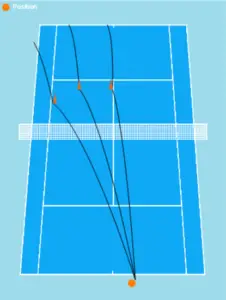Learn the second serve
3 steps to a strong second tennis serve as a beginner
3 steps to a strong second tennis serve as a beginner
The serve is one of the most difficult tennis strokes in terms of coordination and often a source of uncertainty, especially for tennis beginners. While the first serve is usually hit with a lot of force, the second serve often becomes a throw-in or an invitation for the opponent. This does not have to be the case.
The second serve can be strengthened considerably in just three steps, making it more difficult for your opponents, so that you not only win more points, but also your own service games and thus tennis matches.
It is therefore worth devoting training time to improving your second serve. Below we explain to tennis beginners the 3 steps to a strong tennis second serve.
1. Do not tense up but maintain the normal impact motion
Many tennis beginners play the second serve very carefully in order not to produce a double fault and cramp up during the normal serving motion.
Therefore, it is essential to execute the same serving motion on the second serve, but at a slower speed in order to gain more control over the serve.
It is also important that you do not take out too much speed and serve with only 50% of the speed, because this is like an invitation for the opponent and you would be directly put under pressure.
Our recommendation is to serve with a speed of 80%, so that you significantly reduce the error rate of the first serve, gain confidence and still put the opponent under pressure. Roughly speaking, one double fault per set is okay, but it should not be more.
2. Give the tennis ball more spin
Another possibility besides reducing the speed is to give the tennis ball a certain spin, so that the ball bounces differently than normal and it is therefore more difficult for the opponent to play a good return.
The slice serve, which gives the ball a sideways spin, is especially recommended for tennis beginners. Right-handers can spin the ball to the left while left-handers can spin the ball to the right.
Alternatively, a kick serve is also possible, but it requires a little more practice and is therefore not always suitable for tennis beginners. Here the ball bounces with topspin and accelerates again after the bounce.
Of course you should reduce the speed to 80% on the 2nd serve to avoid a double fault.
3. Place the serve
One myth that tennis beginners like to perpetuate is that a good serve always has to be fast. In fact, the placed serve in particular is much more efficient for winning points.

If your opponent has a weakness on the forehand or backhand side, you can try to place the ball on that side. If your opponent is right-handed and keeps making mistakes on the backhand side, try serving from the right side through the middle. This way, your opponent is forced to play a backhand or move well enough to go around the backhand and play a forehand. Neither is easy for the opponent and gives you an advantage.
If the opponent is equally strong on both sides it is important to vary your serves. This applies not only to the first serve but also to the second. Your serve should be as difficult to read as possible, so consciously vary between forehand, body and backhand when placing your serve. Think about where you want to place the serve before you serve, not when you throw the ball.
When placing the serve, try not to play too accurately and aim directly at the lines, but a bit more inside the T-field, so that a double fault is avoided in any case.
If it should happen to you that you make a double fault anyway – as said one double fault per set is okay as a quota – then make sure that you do not initiate a double fault chain. Therefore, after a double fault, plan two second serves to avoid another double fault at all costs. Once you have regained confidence in your serve, you can also open the game normally with a first and second serve.

